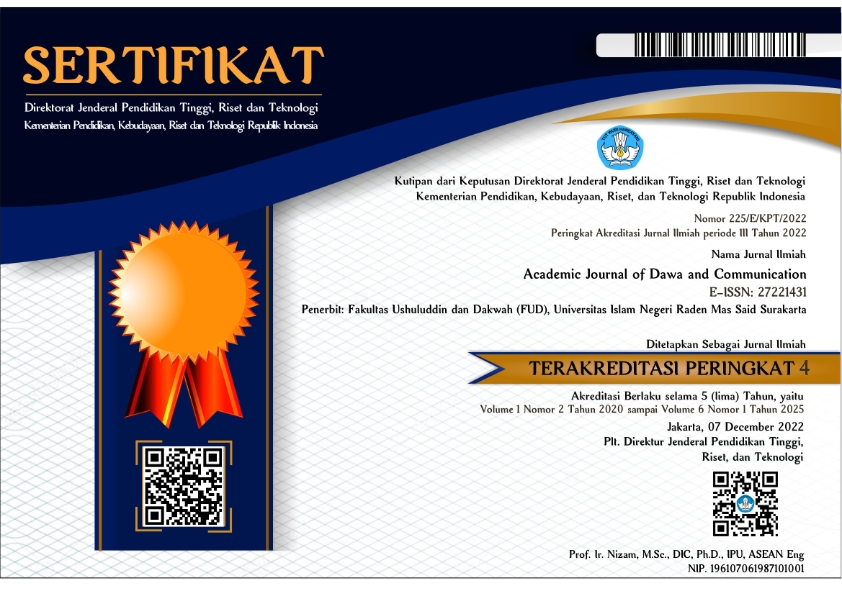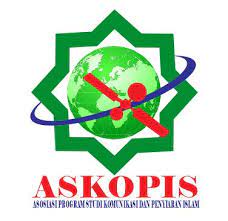Cultural Heritage And City Branding: The Role of Masjid Agung Kubah Timah in Pangkalpinang
DOI:
https://doi.org/10.22515/ajdc.v5i1.8973Keywords:
Cultural Heritage, City Branding, Kubah Timah MosqueAbstract
Bangka Island is famous as the largest tin producer in Indonesia. It has a distinctive history, culture, and religious diversity while upholding tolerance. However, the existence of tin on Bangka Island is not so felt as a symbol or characteristic in Pangkalpinang City as the Capital of the Province of Bangka Belitung Islands. Establishing the Great Mosque of the Tin Dome is currently the city branding of Pangkalpinang City. This study examines how the combination of resources, history, culture, and customs can become city branding. This research uses a descriptive qualitative method. Where the concentration of theoretical focus used is the development of a three-dimensional theoretical model that examines important elements in determining the elements, measurements, and equity of city branding. The data sources are obtained from interviews, secondary data, and also photographs of documentation. The results of the study show that the Great Mosque of the Tin Dome has met the requirements of city branding, namely 1) city brand elementshave met the history, process, graphics, and symbols; 2) city brand measurement is a process that starts from discussion, planning, narrative analysis, and visuals in its construction; and 3) city brand impact is very much felt by the identity, social and economic impact of the mosque's presence.
Downloads
References
Abimayu, Y., & Srinindiati, D. (2019). Sejarah Terbentuknya Kepulauan Bangka Belitung (Pangkalpinang ) Sebagai Sumber Pembelaran Sejarah. Kalpataru: Jurnal Sejarah Dan Pembelajaran Sejarah, 5(2), 112–117.
Abot. (2023). Alhamdulillah... Ditandai Ini, Pembangunan Masjid Agung Kubah Timah Dinyatakan Rampung. https://babelpos.disway.id/read/657620/alhamdulillah-ditandai-ini-pembangunan-masjid-agung-kubah-timah-dinyatakan-rampung
Alza. (2023). Antusias Warga Salat Jumat di Masjid Agung Kubah Timah, Penuh Sesak hingga Halaman Keluar. https://belitung.tribunnews.com/2023/11/24/antusias-warga-salat-jumat-di-masjid-agung-kubah-timah-penuh-sesak-hingga-halaman-keluar?page=2
Ashworth, G. J., & Voogt, H. (1990). Selling the city, London. Belhaven.
Bayliss, D. (2007). The rise of the creative city: Culture and creativity in Copenhagen. European Planning Studies, 15(7), 889–903.
Benedek, J. (2017). Measuring place brand equity: A review of current models. Journal of Media Research-Revista de Studii Media, 10(27), 42–57.
Biel, A. L. (2013). Converting image into equity. In Brand equity & advertising (pp. 67–82). Psychology Press.
Bocquier, P. (2005). World Urbanization Prospects: an alternative to the UN model of projection compatible with the mobility transition theory. Demographic Research, 12, 197–236.
Chang, T. C. (2000). Renaissance revisited: Singapore as a ‘global city for the arts.’ International Journal of Urban and Regional Research, 24(4), 818–831.
Chryshna, M. (2023). Pertambangan Timah: Sejarah, Produksi, dan Ekspor Timah Indonesia. https://kompaspedia.kompas.id/baca/paparan-topik/pertambangan-timah-sejarah-produksi-dan-ekspor-timah-indonesia
Cleland, J. A. (2017). The qualitative orientation in medical education research. Korean Journal of Medical Education, 29(2), 61.
De Jong, M., Hoppe, T., & Noori, N. (2019). City Branding, Sustainable Urban Development and the Rentier State. How Do Qatar, Abu Dhabi and Dubai Present Themselves in the Age of Post Oil and Global Warming? Energies, 12(9), 1657. https://doi.org/10.3390/en12091657
Dinnie, K. (2010). City branding: Theory and cases. Springer.
El Messeidy, R. (2019). Architecture and City Branding: Role of Iconic buildings. Engineering Research Journal, 163, 144–155.
Florek, M., Insch, A., & Gnoth, J. (2006). City council websites as a means of place brand identity communication. Place Branding, 2, 276–296.
Florida, R. (2002). The rise of the creative class (Vol. 9). Basic books New York.
Florida, R. (2006). The flight of the creative class: The new global competition for talent. Liberal Education, 92(3), 22–29.
Gamarra-Ramirez, M. E. S., Peralta-Ugaz, W., Cordova-Buiza, F., & Auccahuasi, W. (2023). City Brand as a Promotional Strategy: A Perception of the Tourist in Peru. International Conference on Management, Tourism and Technologies, 81–89.
Hardi, T. M. (2023). Sah jadi Pj Wali Kota Pangkalpinang, Lusje Anneke Tabalujan: Inflasi dan penanganan stunting prioritas utama. ANTARA 2024. https://babel.antaranews.com/berita/379080/sah-jadi-pj-wali-kota-pangkalpinang-lusje-anneke-tabalujan-inflasi-dan-penanganan-stunting-prioritas-utama
Healey, P. (2004). Creativity and urban governance. DisP-The Planning Review, 40(158), 11–20.
Hospers, G.-J. (2003). Creative cities: Breeding places in the knowledge economy. Knowledge, Technology & Policy, 16(3), 143–162.
Insch, A. (2011). Branding the city as an attractive place to live. In City branding: Theory and cases (pp. 8–14). Springer.
Jokela, S. (2020). Transformative city branding and the evolution of the entrepreneurial city: The case of ‘Brand New Helsinki.’ Urban Studies, 57(10), 2031–2046.
Kurniasih, N. (2024). Salat Ied Perdana di Masjid Kubah Timah Tembus 6000 Jemaah. 2024. https://negerilaskarpelangi.com/2024/04/10/salat-ied-perdana-di-masjid-kubah-timah-tembus-6000-jemaah/
Li, X., Alahmari, A., & Schivinski, B. (2024). Place branding: Religion in shaping the three-dimensional essence of a city brand through stakeholder engagement. PLoS ONE, 19(1 January), 1–16. https://doi.org/10.1371/journal.pone.0296162
Lucarelli, A. (2012). Unraveling the complexity of “city brand equity”: a three-dimensional framework. Journal of Place Management and Development, 5(3), 231–252.
Luerdi, L. (2023). Jakarta’S City Branding As Para-Diplomacy: Beyond Greening Stadium and Race. Janus.Net, 14(1), 142–169. https://doi.org/10.26619/1647-7251.14.1.9
Maranda, S. (2023). Fakta Pembangunan Masjid Kubah Timah Pangkalpinang yang Dirancang Ridwan Kamil. https://travel.tempo.co/read/1781336/fakta-pembangunan-masjid-kubah-timah-pangkalpinang-yang-dirancang-ridwan-kamil
Marlianto, C. (2023). Soal Pembangunan Masjid Agung Kubah Timah, Pemkot Pangkalpinang Minta Pendampingan ke LKPP. https://belitung.tribunnews.com/2022/06/13/soal-pembangunan-masjid-agung-kubah-timah-pemkot-pangkalpinang-minta-pendampingan-ke-lkpp
Maryamah, M., Safitri, A., Bella, H. S., & Sabina, R. (2023). Analisis Nilai-Nilai Pendidikan Islam Pada Tradisi Nganggung di Bangka Belitung. Jurnal Pendidikan Indonesia, 4(10), 1134–1147.
Mihardja, E. J., Widiastuti, T., & Agustini, P. M. (2020). Developing City Branding Strategy of Ternate in North Moluccas - Indonesia. Jurnal Komunikasi: Malaysian Journal of Communication, 36(2), 364–379. https://doi.org/10.17576/JKMJC-2020-3602-22
Mohamad, B., Adetunji, R. R., Alarifi, G., Ismail, A. R., & Akanmu, M. D. (2022). A Visual Identity-Based Approach of Southeast Asian City Branding: A Netnography Analysis. Journal of ASEAN Studies, 10(1), 24–42. https://doi.org/10.21512/jas.v10i1.7330
Nuraini. (2007). Sejarah Terbentuknya Provinsi Kepulauan Bangka Belitung. Tanjung Pinang Departemen Kebudayaan dan Pariwisata Balai Pelestarian Sejarah dan Nilai Tradisional 2007.
OFlaherty, B., & O’Flaherty, B. (2005). City economics. Harvard University Press.
Ooi, C.-S. (2008). Reimagining Singapore as a creative nation: The politics of place branding. Place Branding and Public Diplomacy, 4, 287–302.
Paddison, R. (1993). City marketing, image reconstruction and urban regeneration. Urban Studies, 30(2), 339–349.
Peel, D., & Lloyd, G. (2008). New communicative challenges: Dundee, place branding and the reconstruction of a city image. The Town Planning Review, 507–532.
Scott, A. J. (2006). Creative cities: Conceptual issues and policy questions. Journal of Urban Affairs, 28(1), 1–17.
Siregar, A. P. (2024). Sholat Tarawih Perdana, Masjid Agung Kubah Timah Pangkalpinang Dihadiri Ribuan Jamaah. 2024. https://bangka.tribunnews.com/2024/03/11/sholat-tarawih-perdana-masjid-agung-kubah-timah-pangkalpinang-dihadiri-ribuan-jamaah.
Suharyanto, A. (2016). Potensi Mineral Kasiterit Indonesia Sebagai Bahan Baku Pembuatan Senyawa Kimia Timah (Tin Chemical). Prosiding Semnastek.
Swastiwi, A. W., Nugraha, S. A., & Purnomo, H. (2017). Lintas sejarah perdagangan timah di Bangka Belitung abad 19-20. Direktorat Jenderal Kebudayaan.
Tsavdaroglou, C., & Kaika, M. (2022). The refugees’ right to the centre of the city: City branding versus city commoning in Athens. Urban Studies, 59(6), 1130–1147. https://doi.org/10.1177/0042098021997009
Uysal, Ü. E. (2017). A Brief History of City Branding in Istanbul. In Global place branding campaigns across cities, regions, and nations (pp. 117–131). IGI Global. https://doi.org/10.4018/978-1-5225-0576-1.ch006
Yanto, A., Salbilla, F., & Sitakar, R. C. (2023). Implikasi Resentralisasi Kewenangan Pertambangan Timah Terhadap Potensi Pendapatan Daerah di Bangka Belitung. Jurnal Interpretasi Hukum, 4(2), 344–357.
Zenker, S., & Beckmann, S. C. (2013). My place is not your place--different place brand knowledge by different target groups. Journal of Place Management and Development, 6(1), 6–17.
Downloads
Published
How to Cite
Issue
Section
Citation Check
License

This work is licensed under a Creative Commons Attribution-NonCommercial 4.0 International License.





















